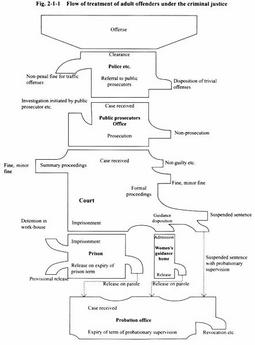| Previous Next Index Image Index Year Selection | |
|
|
This chapter gives an overview of the handling, i.e. treatment of persons cleared by the police etc., through the subsequent processes of prosecution, trial, correction, and rehabilitation (see Part 4, Chapter 2, Section 1 for the treatment of juveniles).
Fig. 2-1-1 shows the flow of treatment for adult offenders. Fig. 2-1-1 Flow of treatment of adult offenders under the criminal justice Cases cleared by the police etc. are (with certain exceptions) all referred to the public prosecutors. The exceptions include those cases subject to disposition of minor offenses , and violations of the Road Traffic Law for which a non-penal fine has already been paid.In addition to investigating these referred cases mentioned above, public prosecutors may initiate investigation themselves as the need arises on a case when they become aware of it or receive a charge or complaint. After completing investigation, public prosecutors decide whether or not the case is to be prosecuted in court, taking into account the existence of a crime, the nature of the evidence, the necessity of punishment and various other circumstances. A prosecuted case may be subject to formal proceedings or summary proceedings. When found guilty in formal proceedings, a sentence of death, imprisonment with or without labor, fine, penal detention, or minor fine may be handed down to the offender. In the case of sentences of imprisonment with or without labor of 3 years or less, or fines of 500,000 yen or less, the execution of sentence may, depending on the circumstances, be suspended for a fixed period. In such cases, the sentence may be accompanied by probationary supervision for the duration of the suspension. In contrast, when subject to summary proceedings, the case results in a fine or minor fine of not more than 500,000 yen, after a quick simple examination of written documents. If a conviction without suspension of execution of sentence is made final, the sentence shall be executed under supervision by public prosecutors. Imprisonment with or without labor and penal detention are carried out in prisons, juvenile prisons, and other penal institutions. Penal institutions give correctional treatment through the execution of the imprisonment sentence, thereby aiming for the reform and social rehabilitation of offenders. Those offenders who are unable to pay fines or minor fines are detained in workhouses attached to penal institutions. Inmates are released and return to society on completion of their sentence. However, in some cases, the Regional Parole Board may decide that an inmate can be released provisionally before the completion of the sentence (release on parole in the case of imprisonment with or without labor, and provisional release in the case of penal detention; provisional release shall also apply to a detainee in workhouses). Inmates released on parole are placed under probationary supervision for the duration of the parole period. Women offenders sentenced to guidance dispositions for Anti-Prostitution Law violations are detained in women's guidance homes. If granted a provisional discharge, they are then placed under probationary supervision. Offenders placed under probation/parole supervision receive guidance, supervision, and protective assistance from probation officers in probation offices and volunteer probation officers, aiming at their reform and social rehabilitation. Explanation of terms Disposition of minor offenses: Judicial police officers do not have to conduct the procedure of referring those minor cases predetermined by public prosecutors, such as larceny, fraud and embezzlement, to public prosecutors. It is called disposition of minor offenses. The details of those minor offenses are reported to public prosecutors by judicial police officers monthly. |
